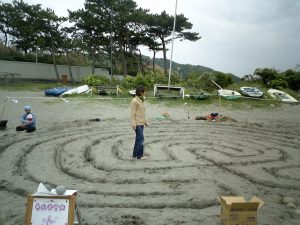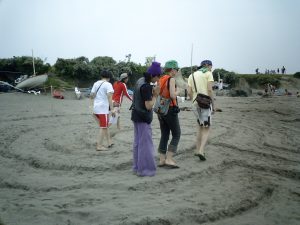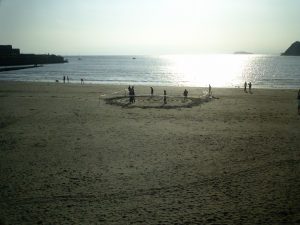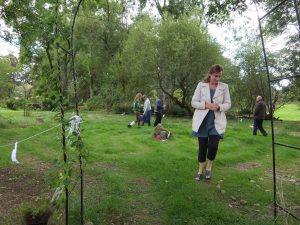
Over the Spring holiday weekend, I mowed the labyrinth for the first time this year. I use a small hand-held machine because the cutting blades of electric machines are too wide. Yes, I could have made my life much easier if I had designed the path to be wider, but this is how it turned out, and so be it.
I first walked a labyrinth in a gymnasium in Yokohama, in or around 2003. Having been invited to one of the city’s international schools to give a mini-workshop to some 40 teachers on Proprioceptive Writing, I was curious to learn that I could take a meditational walk, and made my way to where it was sited: a huge canvas, painted with an 11-circuit design that filled the whole floor space, and lit around the edge with candles. An exact replica of the labyrinth on the floor of the cathedral in Chartres, France, translated…
Just follow the path to the centre, and then follow it back, I was instructed by the labyrinth’s guardian of that time; there are no tricks, you can’t get lost, it’s not a maze.
To say the experience blew me away is no exaggeration. Emotions flared… a problem dissolved…clarity crystalised. Over the next year or so, I became a bit of a labyrinth groupie, following it around Kanto to wherever it was laid to walk. Every time, I learned something new, had questions answered, was shaken by revelations and shocks even. (It’s all those right-brain turns in the ancient design!)
Once I travelled hours out of central Tokyo in a typhoon to a university, where the labyrinth was being made available for students to experience. By the time I got there I was furious to find any number of young people walking the walk. How dare they be here, I can remember thinking; this is my labyrinth. That was a huge lesson for me, and one that made the journey especially worthwhile.
Living by the ocean, I began creating labyrinths on the beach, for others to walk and experience their own realisations and awakenings, or simply de-stress. Initially – as part of a local arts festival – all I could manage to draw out and dig was a very basic design.

The first labyrinth I ever made, a simple 5-circuit on Isshiki-kaigan, but still it drew curious crowds, with many willing to give it a whirl…

Our neighbour Sonia, with husband Yuta and Julia (then three, now 16) on the sidelines. Always hugely supportive… and totally committed to digging and walking…

In the main, Japanese were far more open than non-Japanese. You might think it the other way around, but no…
When we moved to Zushi from Hayama, I became more ambitious, with 7-circuit designs. I would go down early, with lengths of bamboo and string, mark it out for others to come and help dig it out. It became part of the ritual to wait and see the tide take it away…

Tibetan monks create intricate designs (mandela) with coloured sand as gifts to Buddha, then blow them away or casually swipe them with a toe. As tides carry away labyrinths, obliterating their transitory existence, there is a similar sense of unconditionally releasing creation to the universe…
One year, I became so disorientated having walked in circles marking one out early morning, that I fell off my bike on the way home for breakfast, narrowly escaped ending up under a dump truck, and cracking my elbow.

It didn’t stop me though…

There were always walkers…even after I had long gone home.
Moving to Scotland simply provided a new opportunity. The triangle of land to one side of the cottage offered the perfect space for a turf labyrinth so I set about marking it out. Akii was doubtful. He could not see what I could see: the potential. But slowly as it took shape, I erected archways and found a garden bench and chairs and table to paint indigo blue, he became more and more enthusiastic. 
Of course it took a few seasons to mature, the herbs planted around the outer circle to take root and spread. We are still working on it even now…
When our brave and loyal cat, Tora, for Tiger, died, we buried her in the heart of the walkway, marked with a large stone from the side of the burn.
Liam rolled it into the centre… He helped us with the garden until last year when he moved on to manage a local estate. Way to go, Liam!
When Tora’s labyrinth was eventually opened in 2014, everyone agreed that it looked lovely and completely at home. Friends and neighbours came to walk, a few bottles were cracked open, books consulted and questions answered and then some walked again…

A couple wondered what was the point. (What was the point of anything, then?) One went home. (What was the psychological stumbling block?) Whatever the reaction, there is always something to learn, if willing… Life can be very mysterious, if you allow it to be.
I remember a man walking on Hayama-kaigan in 2005 while his wife raged at the entrance, furious to be left alone but not wanting to go herself. Baka, she kept yelling at him, Baka! Fool. The next day she came alone and walked quietly and then left without saying a word. I have always wondered what was going on there, but not my business; these days I try to allow and accept rather than dictate and query. I think the labyrinth’s most powerful message to me was to stop being so controlling; I had no idea.
So, the Burnside Labyrinth is back in business again for the summer. With the information provided printed here to maybe help lure you here one day… whatever the season. 

WELCOME TO THE BURNSIDE (TORA’S) LABYRINTH
Q: WHAT IS THE LABYRINTH? A: The labyrinth is an ancient spiritual tool. It is created here – in turf – as a meditational pathway, a symbolic pilgrimage.
Q: IS THE LABYRINTH THE SAME AS A MAZE? A: No, being left-brained, a maze is designed to trick and tease the mind. By contrast, the labyrinth will lead you easily and safely to the centre and back again, while stimulating right-brain thought processes to creative and problem-solving effect.
Q: IS THE LABYRINTH A SO-CALLED NEW AGE CONCEPT? A: The oldest labyrinth found to date, dated 2,500BC, is on the Mediterranean island of Sardinia. They can be found also in India, Russia, Scandinavia, throughout Europe and the UK, cut into turf, or created with earth, stone or mosaic. The universal spiralling design is integral to many early cultures, including native American Indian, African, Mayan, Greek and Celtic. Replicated in woven baskets, textiles and ceramics, it can be found more naturally in shells, spiders’ webs, and the umbilical cord that connects us to our mother at birth.
Q: WHAT IS THE LABYRINTH FOR? A: As a piece of sacred geometry, the design seems to fulfil some deep spiritual, emotional and physical need. When it became too dangerous for Christians to pilgrimage to the Middle East in the Middle Ages, cathedrals in Europe were ordered to create symbolic pilgrimage routes on the floors of their naves. The classic 11-circuit labyrinth in Chartre Cathedral, France, has more recently been replicated on the floor of Grace Cathedral in San Francisco, USA, where is a craftsman is now kept busy in the basement creating the same design on canvas, so that labyrinths can be transported to churches, schools, hospitals prisons – wherever there is a need for reflection, healing and transformation. Labyrinths carved into wood are used by the visually-impaired who can trace the route with their fingers to relaxing holistic effect.
Q: IS THERE A RIGHT WAY TO WALK? A: There is no right – or wrong – way. Everyone has their own journey, as in life. You may walk and think, So what? You may find it reduces stress. There may be revelations – with feelings of happiness, discontent, impatience – questions, or solutions to problems/ enquiries. Walk at your own speed, with an open mind, an open heart. When you reach the centre, pause. You are (symbolically) at the centre of the universe, the world, your Self. Acknowledge your arrival, your state of Being. Stand or sit while. Then return. If you meet anyone on the path, simply step aside. You can NOT fall off! Enter and return by the same route. Try not break the circle.
Q: CAN I WALK MORE THAN ONCE? A: As often as you like. Simply take time in-between to consider feelings and reactions. Come back whenever you want or need.
Q; WHERE CAN I LEARN MORE ABOUT THE LABYRINTH? A: There are many books and over two million websites. Search “labyrinth” and see what turns up. Recommended: www.labyrinthsociety.org www.lessons4living.com/labyrinth.htm www.angelfire.com/tn/SacredLabyrinth http://www.pinterest.com/angelajeffs/labyrinths/
NEGOTIATING THE LABYRINTH IS LIKE TAKING A THOUGHTFUL WALK. THERE ARE FOUR STAGES:
THE THRESHOLD… or entrance of the labyrinth, where the details of everyday life are shed and the mind becomes receptive
JOURNEYING IN… finding out how the mind focuses as the body moves forward towards the labyrinth’s centre
THE RESTING PLACE… arriving at the centre, then pausing to await inspiration
JOURNEYING OUT… discovering a rebirth and preparing to re-enter the outside world with a new sense of purpose. As you exit, maybe turn and say thank you?
OPTIONAL: THE STONES ON THE TABLE: CHOOSE ONE (THAT ATTRACTS ATTENTION, CALLS TO YOU) AND CARRY IT WITH YOU TO THE CENTRE, REPRESENTING SOMETHING YOU WANT TO GET RID OF OR LEAVE BEHIND (ANGER, RESENTMENT, FEAR). LEAVE IT IN THE CENTRE AND RETURN. EQUALLY THERE MAY BE SOMETHING YOU WANT TO BRING BACK INTO DAILY LIFE (ACCEPTANCE, COURAGE, PURPOSE).

